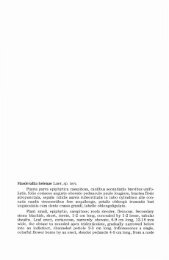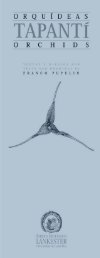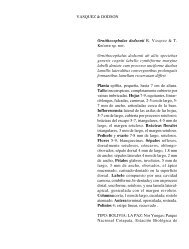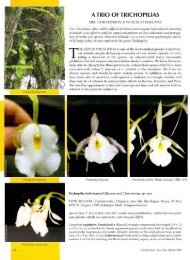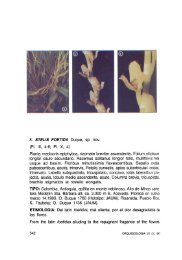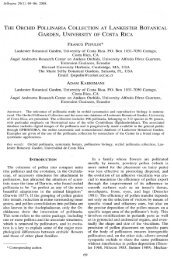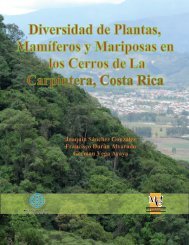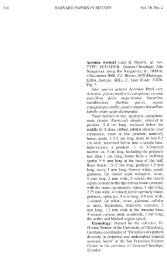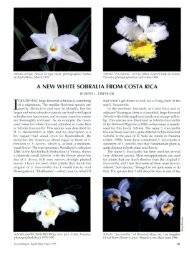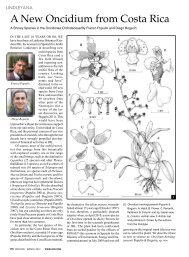The orchid flora of Cocos Island National Park ... - Epidendra
The orchid flora of Cocos Island National Park ... - Epidendra
The orchid flora of Cocos Island National Park ... - Epidendra
Create successful ePaper yourself
Turn your PDF publications into a flip-book with our unique Google optimized e-Paper software.
distinguished by the inflorescences having two<br />
whitish flowers, > 1 cm in length, the column apex<br />
with two teeth in each side and the lateral lobes <strong>of</strong> lip<br />
covering the column apex.<br />
<strong>The</strong> <strong>flora</strong>l features <strong>of</strong> the three Epidendrum spp.<br />
are similar. <strong>The</strong> only specimen collected for this study<br />
seems to be intermediate between E. cocoense and<br />
E. insulanum. Basically, the lip shape is similar to<br />
E. cocoense, with the same callus structure, but<br />
having rounded basal lobes and acute apex as in<br />
E. insulanum. <strong>The</strong> sepals and petals are as long as<br />
those <strong>of</strong> E. cocoense, but the shape is more similar to<br />
E. insulanum. Plant size is intermediate between the<br />
two species. <strong>The</strong> column shape also shares intermediate<br />
characteristics. <strong>The</strong> column is oblong as in<br />
E. insulanum but with two teeth at apex as in<br />
E. cocoense.<br />
Trusty (2006) was unable to distinguish this species<br />
from E. insulanum. <strong>The</strong>y suggested the possibility<br />
that this species could be a hybrid between E.<br />
cocoense and E. insulanum and observations <strong>of</strong> <strong>flora</strong>l<br />
morphology support their hypothesis. However, more<br />
evidence is needed to complement the morphological<br />
data, especially at population genetics and reproductive<br />
biology levels.<br />
Conservation status: Trusty (2004) suggested classifying<br />
this species as CR because <strong>of</strong> criterion B and D.<br />
<strong>The</strong> estimation <strong>of</strong> the EOO is < 1km 2 . This species is<br />
very rare and restricted to the Wafer Bay areas<br />
around the Genio River where it is known from less<br />
than five collections. This species has not been evaluated<br />
yet under IUCN criteria; however, it should be<br />
classified as CR as suggested by Trusty (2004).<br />
<strong>The</strong> endemic Epidendrum species: <strong>The</strong> three Epidendrum<br />
spp. are similar in their vegetative morphology.<br />
All the species have a pendent branching habit. <strong>The</strong><br />
inflorescence is terminal and new branches are produced<br />
beneath the apex after they have flowered. <strong>The</strong><br />
new branches flower again. Flowers are superficially<br />
similar. <strong>The</strong> lip is cordate or subcordate with the<br />
callus always Y-shaped. <strong>The</strong> column has a reduced<br />
clinandrium and shows little variation between<br />
species. <strong>The</strong> perianth segments show some variation<br />
in size and their shape varies from oblong to<br />
ovate–elliptic.<br />
Relationships with other members <strong>of</strong> the genus<br />
Epidendrum: According to Hágsater (2007), they are<br />
members <strong>of</strong> the Epidendrum ramosum Jacq. group,<br />
which is characterized by the monopodial branching<br />
stems, the spike-like distichous inflorescence and the<br />
lip with a single callus and the flexicaule subgroup,<br />
ORCHID FLORA OF COCOS ISLAND 35<br />
which has a straggling habit, the main stem not very<br />
evident and the dorsal keel present in the sepals,<br />
which is generally prominent.<br />
Epidendrum insulanum is closely related to E.<br />
flexicaule Schltr., E. stevensii Hágsater, E. modestiflorum<br />
Schltr and E. veraguasense Hágsater (Hágsater,<br />
2007), but they can be distinguished: E. flexicaule has<br />
longer leaves (up to 8.2 cm long) and two or three<br />
larger flowers, E. stevensii has two or three smaller<br />
flowers, E. modestiflorum shorter wider leaves<br />
(5 ¥ 15 cm) and two or three flowers and E. veraguasense<br />
has two or three white, larger flowers. Epidendrum<br />
jimenezii is perhaps closely allied to E.<br />
insulanum and E. cocense. Being sympatric and<br />
having similar plant size, E. jimenezii and E. insulanum<br />
are sometimes confused.<br />
Epidendrum cocoense is vegetatively similar to E.<br />
rafael-lucasii Hágsater, E. santaclarense Ames and E.<br />
acunae Dressler. <strong>The</strong>y are found in Central America<br />
and Panama, with the exception <strong>of</strong> the Costa Rican<br />
endemic E. rafael-lucasii. According to Hágsater<br />
(1999a), E. rafael-lucasii has larger yellow flowers (vs.<br />
white), sepals 16–20 mm long (vs. 12 mm in E.<br />
cocoense) and the column is blunt at the apex (vs.<br />
with two teeth at each side <strong>of</strong> apex). Epidendrum<br />
santaclarense has deep green flowers (vs. white) and<br />
E. acunae has shorter stems and very short flowering<br />
stems.<br />
Pollination <strong>of</strong> endemic species <strong>of</strong> Epidendrum: <strong>The</strong><br />
pollination biology is unknown. Epidendrum spp.<br />
have a deep tube inside the ovary, sometimes with<br />
free nectar. <strong>The</strong> lip and column made up a simple<br />
horizontal tube, with the free part <strong>of</strong> the lip used as<br />
an appendage for pollinator attraction. Some species<br />
<strong>of</strong> Lepidoptera, mainly moths, are important pollinators<br />
<strong>of</strong> members <strong>of</strong> subtribe Laeliinae Benth., including<br />
Epidendrum (van der Pijl & Dodson, 1966). <strong>The</strong><br />
white to whitish flowers <strong>of</strong> E. cocoense produce a<br />
perceptible sweet smell and they could attract some<br />
species <strong>of</strong> moths or butterflies. Nearly 100 species<br />
<strong>of</strong> Lepidoptera are recorded from <strong>Cocos</strong> <strong>Island</strong> and<br />
moths are the largest group (Brown, Donahue &<br />
Miller, 1991; Brown & Miller, 1999). As there are no<br />
bees in the island, it is highly probable that the<br />
Epidendrum spp. are pollinated by Lepidoptera. Selfpollination<br />
was not observed and plants in cultivation<br />
flowered without producing fruits.<br />
3. ORNITHIDIUM SALISB. EX R.BR.<br />
ORNITHIDIUM SALISB. EX R.BR., Hort. Kew. ed. 2, 5:<br />
210. 1813. Type species: Epidendrum coccineum Jacq.,<br />
Enum. Syst. Pl. 29. 1760. = Ornithidium coccineum<br />
(Jacq.) Salisb., Trans. Hort. Soc. London 1: 293. 1812.<br />
EPIPHYTIC, sympodial (caespitose to rhizomatous)<br />
or monopodial plants; rarely with dimorphic growth.<br />
© 2011 <strong>The</strong> Linnean Society <strong>of</strong> London, Botanical Journal <strong>of</strong> the Linnean Society, 2011, 166, 20–39



